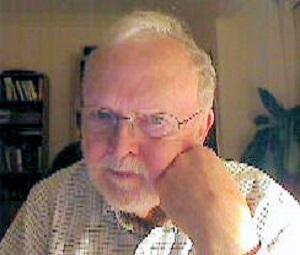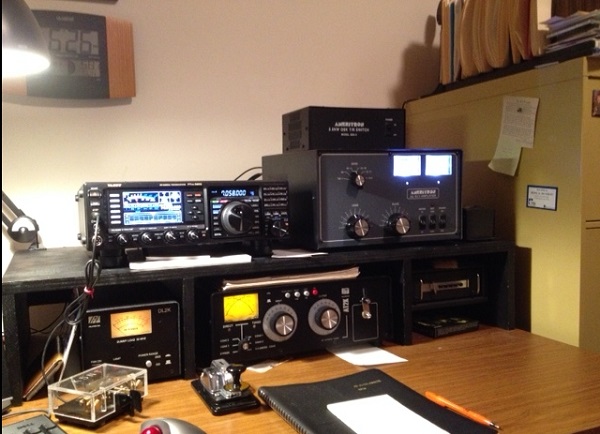|
K5NT David B. Farris Richmond, VA QCWA # 11805 Chapter 67 |
 |
I was first licensed as WN3VBP in Washington, DC in December of 1952 at age 15. My next call was W3VBP, as back then they just dropped the "N" when you upgraded from Novice to Technician or General. My first rigs were a modified surplus rig for two meter AM, and a homebrew 35 Watt CW transmitter for 80 and 40 from the ARRL Handbook (6AG7/6L6 with crystal control). My HF antenna was a Windom, a wire antenna fed off-center with 300 Ohm twinlead. My next transmitter was a World Radio Labs Globe Scout 60 with a Hallicrafters VFO. My first "decent" receiver was a National NC-125, but I was able to upgrade when I found a Collins 75A-1 in a high fidelity store that had been taken in on trade. Later I operated SSB using a Central Electronics 20A with a homebrew VFO and a Globe Linear into a trap vertical on a pole in the back yard. When I moved to Texas in 1965 it was possible to hold two callsigns at once, and I became W5PBW also. I have held K5NT since 1977, and I believe I am the first to hold that call.
I retired in 2003 after 44 years in the workplace, but became restless after a few years and took a part-time job as Executive Director of a small museum and archives. My spare time is spent in working CW and a little SSB on HF, and studying classical guitar. I also exercise without grumbling about it too much.
The QTH is in a subdivision that makes it difficult to put up outdoor antennas. I installed an Alpha Delta DX-EE dipole in the attic, and it works very well as I seem to be able to work any station I can hear. Of course, I know that I would hear and work more with a better antenna, but I am having fun with this setup. My main rig is a Yaesu FTdx-3000D, and an Ameritron AL-811 amp with Ameritron's QSK-5 accessory if I want a little more power out because of conditions.
This shot is taken with the video camera on the computer monitor I use for Skype contacts with family.
Here are my membership and certificate numbers, if anyone is interested:
QCWA #11,805. FISTS #7409, plus CC, Silver, & Platinum. G-QRP #10378. SKCC #1427. I am a Life member of the ARRL.
----------------------------------------------------------------------------------------------------------------------------------------
All of the above info is the "Executive Summary" of my time in ham radio. As time permits, I will begin to add details that some may find interesting.
When I was a kid we lived in the 5100 block of 44th St. NW in Washington, DC. I had a friend across the street named Jack Markham, and next door to Jack lived his cousin Bobby Shoemaker, who was a ham. Bobby had his shack in a side porch that had been enclosed, and if I peered through his windows I saw lots of equipment in 6' racks and on his desk. I don't think I was ever invited inside, but my friend Jack was always bragging about Bobby's contacts. I decided about then that someday I would be a ham also.
A few years later, we moved a few blocks away to Fessenden St., NW. My father finally got tired of me talking constantly about becoming a ham, and told me to get busy and start studying for my license. I discovered that there was a radio club in DC that was accessible by streetcar, so I began attending their meetings. It was called the Washington Radio Club, and met in a downtown building owned by the phone company. The shack was on the top floor, accessed by a cramped elevator whose creaks and groans still haunt an occasional dream. It had two Collins setups and some surplus gear as I recall, and there was a yagi on a short tower on the roof and a few wire antennas. There I met Ron Ginsburg, W3TIC, Ed Levitt, W3TBO, Ethel Smith, W3MSU, and Elizabeth M (Emzie) Zandonini, W3CDQ. There were others there, but my friendships with these four continued for many years and still exist today. Ethel and Emzie are SK, but Ed and Ron are still vertically polarized as of February, 2015.
In high school (Woodrow Wilson) I was President of the Radio Club for a year or so. We had no station in the school, but held interesting meetings at which we discussed equipment and antennas and fibbed about our contacts. My 1955 yearbook is annotated with the callsigns of the hams at Wilson in those days; Frank Eliot, W3WAG, Carol Smith, Willard Cronyn, Dave Belsley, W3VBO, Neil Muncy, . . .
Emzie, W3CDQ, lived not too far from my place on Fessenden St. I don't know how old she was at that time, but I think that she had retired from her day job by then. She used end-fed wire antennas, and my job as a fearless teenager was to climb the trees and telephone poles that held the far ends of her wires. This was an all-year job which was especially difficult in the winter when ice storms seemed to cause her wires to ice up and fall, requiring me to make slippery climbs to secure them once again. Emzie's rig consisted of a National HRO Senior receiver and a Johnson Viking I transmitter. Later on she upgraded to a Viking II (built from a kit for her by Ralph V. (Andy) Anderson, W3NL) and she paired this with a new National HRO 60. She was a CW operator exclusively! Ethel Smith, W3MSU, was an engineer with the Navy, and a member of the Naval Reserve where she held the rank of CT1(R). I later joined her reserve unit and achieved the rank of CT2(R) before the end of my enlistment. W3TBO and W3TIC were also members of the unit. W3TIC had many adventures on active duty, one of which was immortilized in a book currently available at Barnes & Noble and other stores.
One of the things we could do in those days was go over to the Pentagon and use the military ham stations. There was a small building constructed in the Concourse containing two stations - K4AF (Air Force) and K4USA (Army). Local hams were allowed to operate the stations subject to the Military Affiliate Radio System (MARS) schedules of the stations and the friendliness of the station managers. As you might expect the stations were very well equipped, with mostly Collins equipment. I remember seeing KW-1 transmitters and 75A-3 receivers in abundance. If those stations are still there in 2015, I would bet that access to them is more limited than it was back in the 1950's. Back then, you could park next to the building and enter through a single door that was left unlocked. From there, a stairway led up to the Concourse that was also lined with retail stores for the convenience of the workers in the Pentagon like the indoor malls of today.
I have a few regrets connected with the Naval Reserve. First, I should have stayed in and worked toward becoming a Chief Petty Officer (the two best ranks in the Navy are, IMHO, Chief Petty Officer and Captain). Second, I wish that I had been able to get a commission. Ed, W3TBO and I met the qualifications of a program to do so, but our timing was bad and the single commission available at that time went to an admiral's son. Considering the times, that may have been a lucky thing for me. I would probably have ended up as an officer on the USS Pueblo.
My formal education, consisting of college and law school, was valuable. It was my ham ticket, however, that led to all the good jobs I was able to get early in my work history. My General Class license enabled me to join the Naval Reserve at the E3 (Seaman) level, making it a desirable move to make since I had to satisfy a military obligation in some way. In 1964 one of the officers in my reserve unit hired me to work for his company, which had just received a Navy contract to supply personnel to the Bureau of Ships. Through that job I met the man who hired me to be business manager of a new company he was starting. and from that 11-year experience came many other contacts that served me well until my retirement.

April 05, 2017